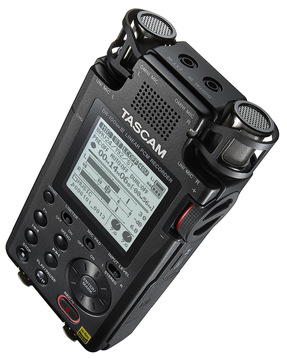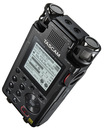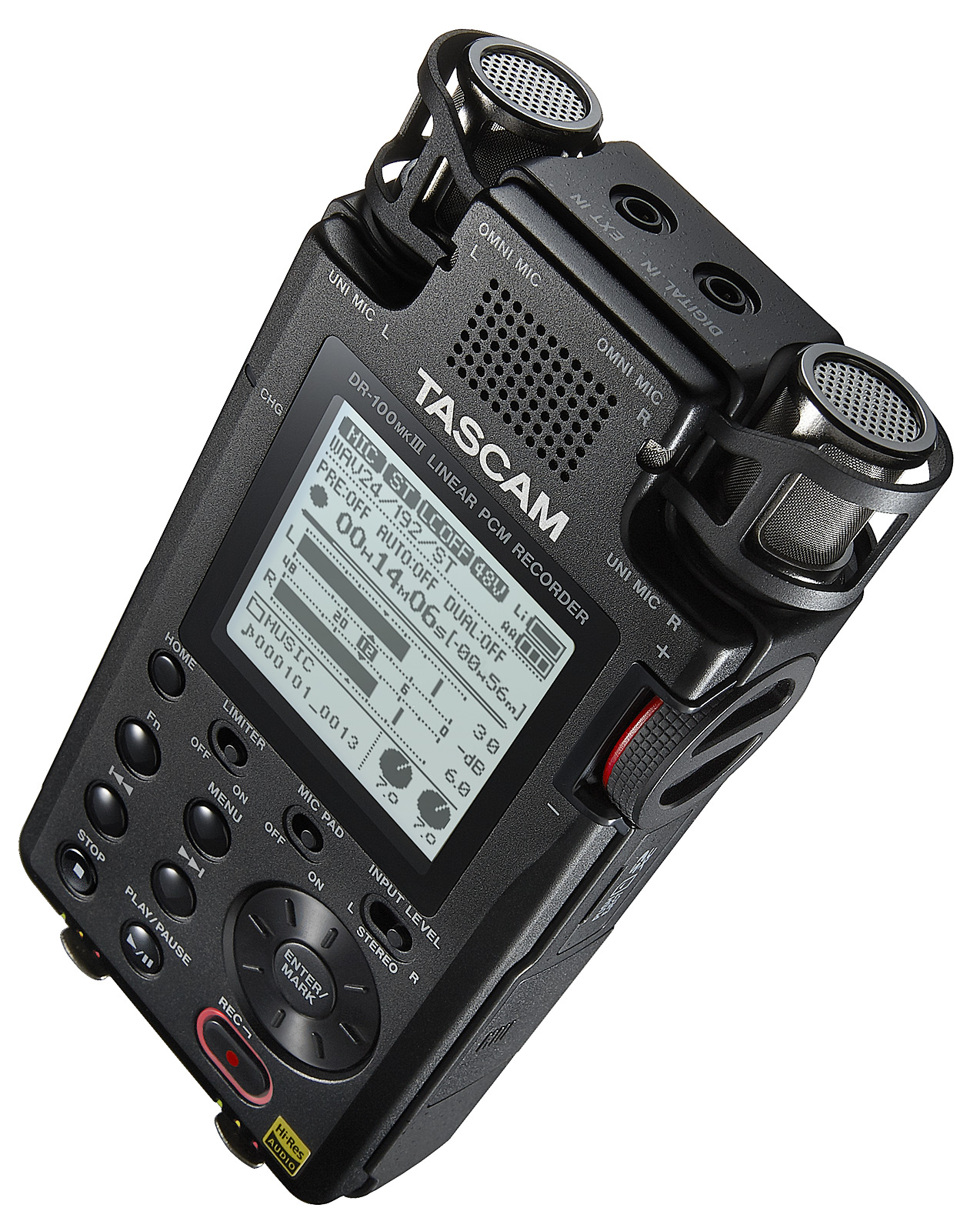TASCAM DR100MK3 Professional Handheld Recorder
Product Code: TAS-DR-100MK3
This recorder is unlikely to be available again in New Zealand. Please refer back to the "Audio Recorders" category for alternatives.
The DR-100MKIII is Tascam’s top-of-the-line portable, delivering the best audio performance in the history of Tascam stereo handheld recorders. Designed to meet the needs of the most demanding audio designers and engineers, this third generation of the DR-100 combines robust reliability, an easy-to-use interface and studio-quality sonic performance.
You can record directly from the built-in uni-directional or omni-directional stereo microphones, connect your own mics to the rugged locking Amphenol XLR/TRS connectors, use a camera microphone or line source for recording or record from a digital SPDIF source. 24 or 48 volts of Phantom power on the XLR inputs are available for the use of studio condenser mics and Mid/Side microphone configurations can be decoded before or after recording. This ensures that virtually all fields of application are covered – from music, speech and atmosphere recordings to meeting minutes and live concert recordings.
Many other improvements and new features as well as the multilingual menu make the DR-100MKIII an easy-to-use companion for sound recordings at the highest level.
| Features | DR-100 MKIII | DR-100 MKII |
|---|---|---|
| Maximum sampling rate | 192 kHz | 96 kHz |
| Recording media | SDXC (up to 128 GB) | SDHC (up to 32 GB) |
| AD/DA converter for external input | AKM AK4558 | AKM AK4556 |
| Audio clock accuracy | 1 ppm (TCXO) | 30 ppm |
| Display size | 128×128 | 128×64 |
| Menu language | EN/FR/ES/DE/IT/JP | EN |
| Headphones output | 40 mW + 40 mW | 25 mW + 25 mW |
| Low-cut filter | 40/80/120/220 Hz | 40/80/120 Hz |
| Peak reduction | Yes | No |
| Power-on recording | Yes | No |
| Dual level recording | Yes | No |
| Dual format recording | Yes | No |
| Floating structure for unidirectional mics | Yes | No |
| XRI function (stores recording information) | Yes | No |
| Slate tone generator | Yes | No |
| Connectors for external input | Amphenol XLR/TRS combo | XLR |
| General | |
|---|---|
| Recording media | SD card (64 MB−2 GB) SDHC card (4−32 GB) SDXC card (48–128 GB) |
| Recording/playback formats | WAV (BWF): 44.1/48/88.2/96/176.4/192 kHz, 16/24 bits MP3: 44.1/48kHz, 128/192/256/320 Kbit/s |
| Number of audio channels | 2 channels (stereo) |
| Analogue audio inputs and outputs | |
|---|---|
| MIC/LINE IN jacks (XLR support phantom power) | XLR-3-31 (1: GND, 2: HOT, 3: COLD) 6.3-mm standard TRS jacks (Tip: HOT, Ring: COLD, Sleeve: GND) |
| When MIC input source selected | |
| Maximum input level | +2 dBu (PAD on) |
| Minimum input level | –70.5 dBu (PAD off) |
| Input impedance | XLR: ≥2 kΩ TRS: ≥20 kΩ |
| When LINE input source selected | |
| Maximum input level | +24 dBu |
| Nominal input level | +4 dBu |
| Input impedance | ≥20 kΩ |
| EXT IN jack (can provide plug-in power) | 3.5-mm stereo mini jack |
| When EXT MIC input source selected | |
| Maximum input level | –2.8 dBu (PAD on) |
| Minimum input level | –62.8 dBu (PAD off) |
| Input impedance | ≥50 kΩ |
| When EXT LINE input source selected | |
| Maximum input level | +6 dBV |
| Nominal input level | −10 dBV |
| Input impedance | ≥2 kΩ |
| LINE OUT jack | 3.5-mm stereo mini jack |
| Output impedance | 200 Ω |
| When LINE input source selected | |
| Nominal output level | –14 dBV |
| Maximum output level | +6 dBV |
| In other situations | |
| Nominal output level | –10 dBV |
| Maximum output level | +6 dBV |
| Headphones jack | 3.5-mm stereo mini jack |
| Maximum output power | 40 mW + 40 mW (headphones connected, 32 Ω load) |
| Built-in speaker | 0.4 W (mono) |
| Digital input | |
|---|---|
| DIGITAL IN connector | 3.5-mm TRS jack (using dedicated conversion cable) |
| Format | IEC60958-3 (SPDIF) |
| Other inputs and outputs | |
|---|---|
| USB port | Micro-B connector |
| Format | USB 2.0 HIGH SPEED mass storage class |
| REMOTE jack | 2.5-mm TRS jack |
| Audio performance | |
|---|---|
| Frequency response | MIC/LINE IN (MIC, PAD On) to LINE OUT MIC/LINE IN (LINE) to LINE OUT EXT IN (MIC, PAD On) to LINE OUT EXT IN (LINE) to LINE OUT |
| 44.1/48 kHz sampling frequency (JEITA) | 20 Hz − 20 kHz +0.5 dB/−1 dB |
| 88.2/96 kHz sampling frequency (JEITA) | 20 Hz − 40 kHz +0.5 dB/−2 dB |
| 176.4/192 kHz sampling frequency (JEITA) | 20 Hz − 80 kHz +0.5 dB/−4 dB |
| Distortion | MIC/LINE IN (MIC, PAD On) to LINE OUT MIC/LINE IN (LINE, +20dBu In) to LINE OUT EXT IN (MIC, PAD On) to LINE OUT EXT IN (LINE) to LINE OUT |
| 44.1/48/88.2/96/176.4/192 kHz sampling frequency (JEITA) | ≤0.007 % |
| S/N ratio | MIC/LINE IN (MIC, PAD On) to LINE OUT MIC/LINE IN (LINE) to LINE OUT EXT IN (MIC, PAD On) to LINE OUT EXT IN (LINE) to LINE OUT |
| 44.1/48/88.2/96/176.4/192 kHz sampling frequency (JEITA) | ≥102 dB |
| Equivalent input noise (EIN) | ≤–124 dBu |
| Note: based on JEITA CP-2150 |
| Power supply and other specifications | |
|---|---|
| Power supply | Built-in lithium-ion rechargeable battery 2 AA batteries (alkaline, NiMH or lithium-ion) USB bus power from a computer AC adapter (Tascam PS-P520E, sold separately) Battery pack (Tascam BP-6AA, sold separately) |
| Power consumption | 7.5 W (maximum) |
| Approximate battery operation time (continuous operation in hours:minutes) | |
|---|---|
| Use conditions | UNI MIC (built-in directional mic) input Phantom power unused STEREO WAV (BWF)/44.1 kHz, 16-bit recording |
| Using built-in (lithium-ion rechargeable) battery | 12:00 |
| Using lithium batteries (Energizer Ultimate Lithium) | 7:00 |
| Using NiMH battery (eneloop) | 3:30 |
| Using alkaline batteries (Evolta) | 2:45 |
| Use conditions | MIC/LINE IN jack/mic input Phantom power used (+48V, 2 × 3 mA) STEREO WAV (BWF)/44.1 kHz 16-bit recording |
| Using built-in (lithium-ion rechargeable) battery | 6:00 |
| Using lithium-ion batteries (Energizer Ultimate Lithium) | 3:30 |
| Using NiMH battery (eneloop) | 2:15 |
| Using alkaline batteries (Evolta) | 1:00 |
| Charging time | By USB: about 10 hours Using PS-P520E: about 4½ hours |
| Dimensions (w × h × d) | 80 mm × 156 mm × 35 mm (excluding protrusions) |
| Weight | 425 g (including batteries) 375 g (excluding batteries) |
| Operating temperature range | 0–40 °C |
Tascam

We can get the whole range, just tell us if you want anything. TASCAM is the professional audio division of TEAC Corporation, headquartered in Montebello, California. Tascam is credited as the inventor of the Portastudio, the first cassette-based multi-track home studio recorders. Tascam also the...




